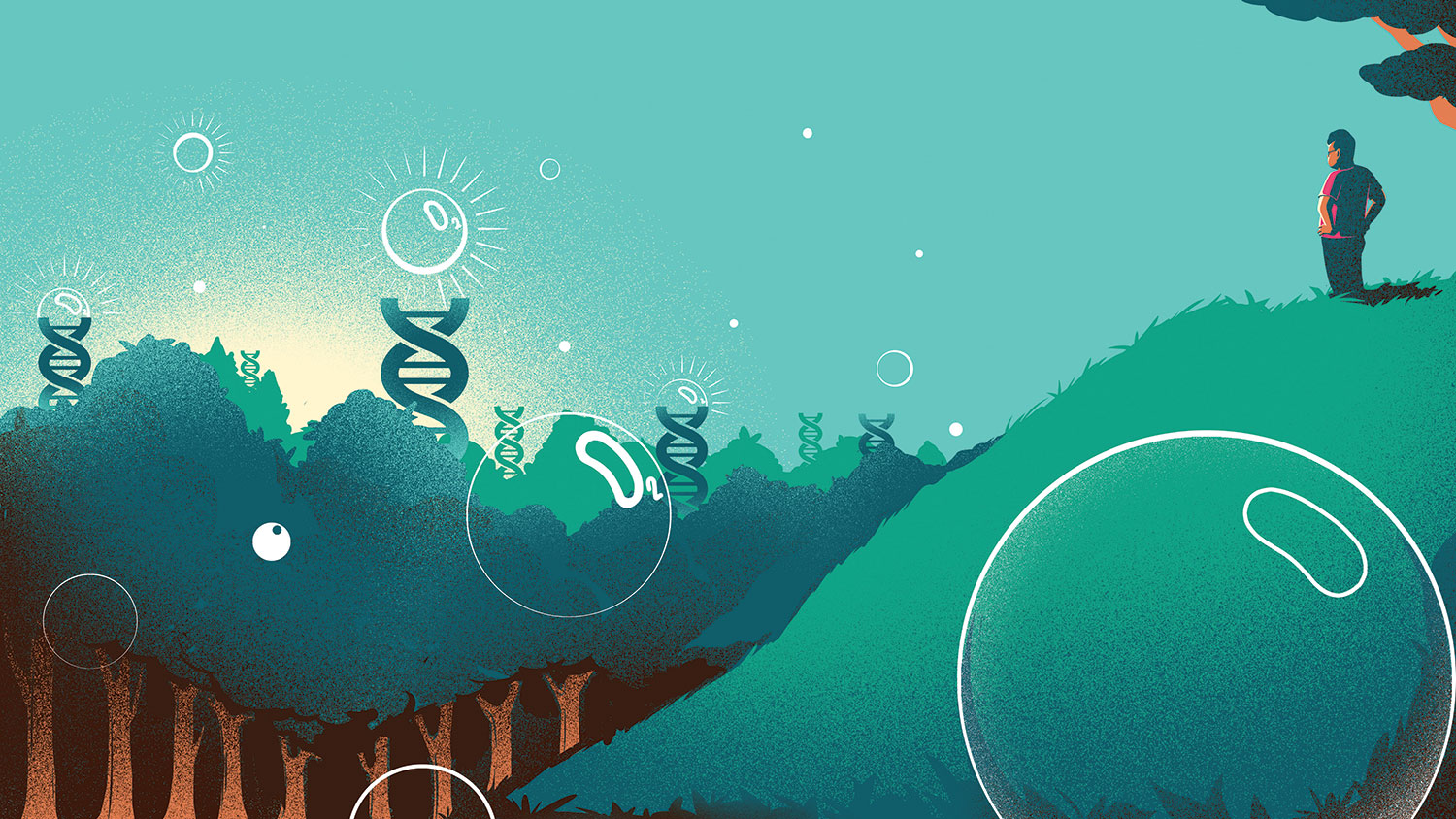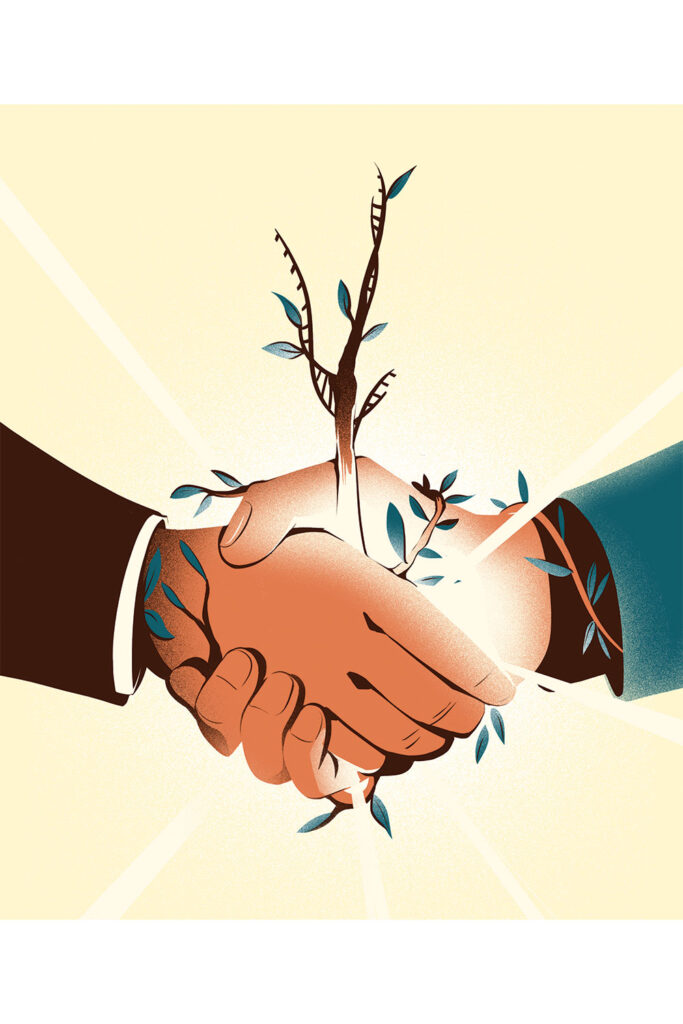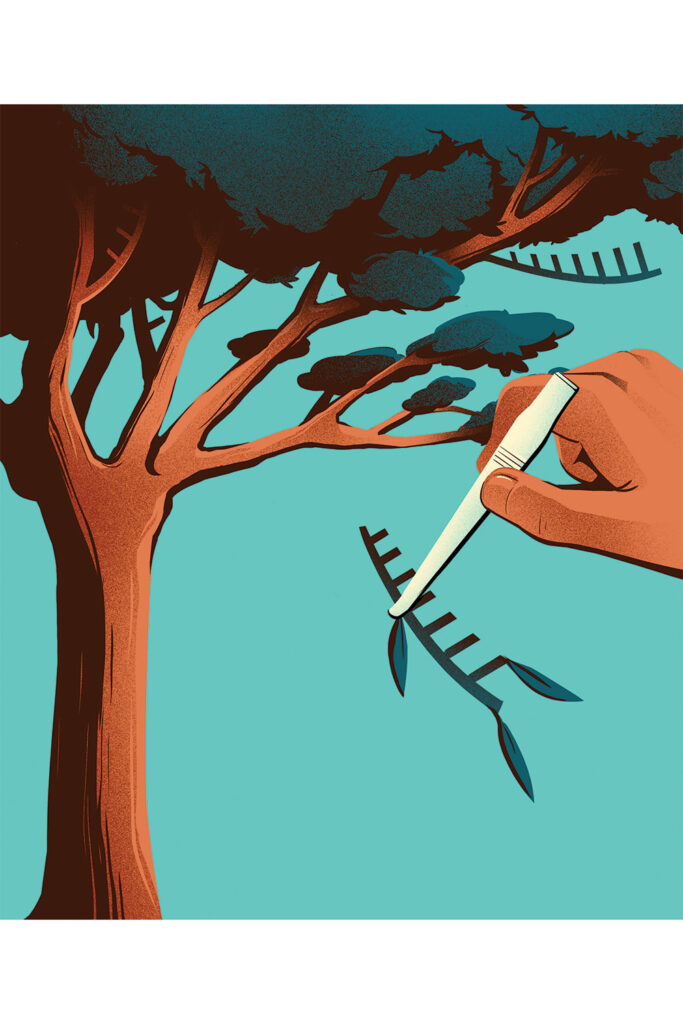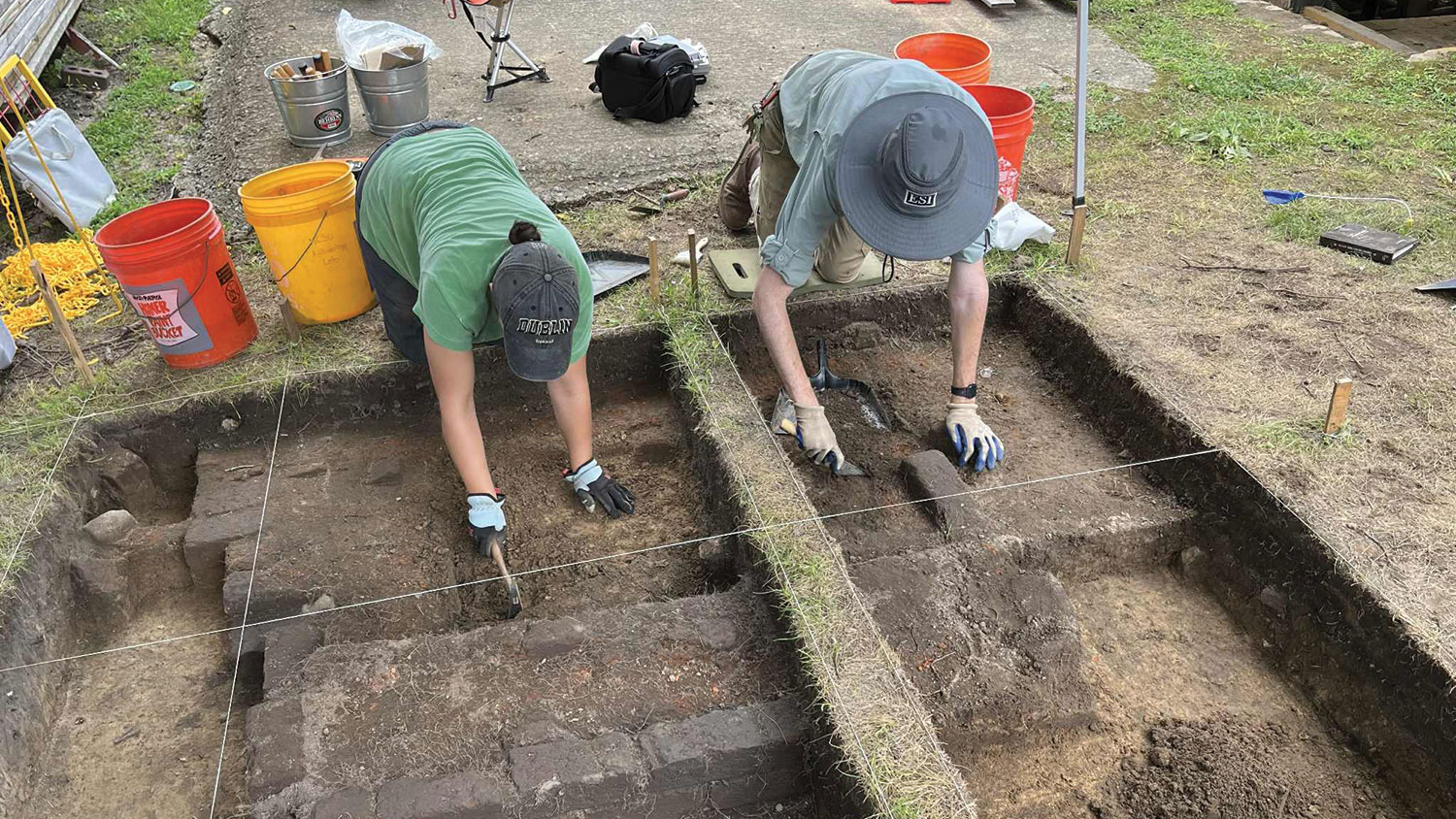A CRISPR View
Forestry professor Jack Wang ’12 PHD calls on gene editing to change the business of trees — and maybe a lot more. Illustrations by Eric Chow

Jack Wang ’12 PHD has been around trees — and science — his whole life. As a kid, he would hang out in the lab in Taiwan where his father worked as a forest pathologist. When his family moved to New Zealand in the early 1980s for his dad’s new job managing a large seed orchard, Wang spent his spare time camping, fishing and hunting among the giant redwoods near the town of Rotorua where they lived. “I’ve always been a tree guy,” he says. “I never really thought of doing anything else.”
Which is why Wang is now an associate professor of forestry at NC State and director of the Forest Biotechnology Group, which was established in 1988 to put the university on the cutting edge of research in tree genetics. So several years ago, when Wang started working with a new technology to edit the genomes of trees, he had a pretty good idea that he was onto something important. That something was a new way of breeding trees, which could reduce the carbon emissions of trees when they are used to produce paper and other pulp products like diapers and toilet paper. It’s also possible the work could eventually make trees more resilient during periods of drought and more resistant to pests. And Wang says the research could lead to any number of other changes, even editing trees so that people would no longer have to worry about the lumber they buy at hardware and home improvement stores being bowed.
Such developments — particularly in the pulping process — could be a boon to the timber industry, leading to increased production from managed forests and decreased energy costs. It could help meet the rising demand for paper and pulp products at a time when land dedicated to forests is dwindling. Wang and his team have already demonstrated enough success, working with poplar trees, that one large multinational timber company has shown interest in the work.
Editing the genes of trees could ultimately contribute to the battle against climate change. Many scientists argue that trees, with their ability to capture and store carbon while emitting pure oxygen, could be one of the planet’s best weapons against environmental stressors. What Wang is working on could dramatically bolster trees in that effort.
“It will allow us to make our paper more efficiently,” he says. “It will allow us to make better timber products. It will allow us to reduce carbon emissions from pulp and paper mills as well as make trees healthier and more productive.
“It’s all wonderful things that have the potential to transform the whole industry.”

CRISPR Companions
It was not until Wang met with Rodolphe Barrangou ’00 MS, ’04 PHD, the Todd R. Klaenhammer Distinguished Professor in Probiotics Research, that he realized just how important this work could be.
Barrangou is extremely familiar with the technology Wang was using. It’s known as CRISPR (which stands for Clustered Regularly Interspaced Short Palindromic Repeats, and is pronounced “crisp-er”), and it is revolutionizing everything from the food we eat to the treatment of diseases. Barrangou was one of the first people to realize the potential of CRISPR when he was working with yogurt bacteria in the early 2000s as a food scientist at DuPont. He has received multiple awards for his efforts using CRISPR to improve starter cultures for the dairy industry, and he says that virtually anyone who has eaten yogurt or cheese in the past decade has eaten food that used CRISPR, a targeted gene-editing system that removes DNA from a specific genetic location, much like deleting words from a line of text in a word processing document.
What Wang really needed from Barrangou was the experience and knowledge Barrangou had after starting a handful of companies to put the work he was doing in the lab out into the world. “I really try to translate great science and great technology into actual commercial pursuits and products,” says Barrangou, who has an MBA and a master’s degree in biological engineering in addition to his graduate degrees from NC State in food science and functional genomics. “I’m a practical guy.”
It didn’t take long for the “tree guy” and the “practical guy” to figure out that they had the potential to make a bit of magic together.
It didn’t take long for the “tree guy” and the “practical guy” to figure out that they had the potential to make a bit of magic together. Given his knowledge of CRISPR and its success in modifying various agriculture crops, Barrangou had no doubt that what Wang was attempting — editing the genomes of trees to develop whatever trait was desired — could be done. “It will absolutely work,” Barrangou says, recalling his initial reaction to what Wang told him. “It’s like a foregone conclusion. All the ingredients are there.”
What caught Barrangou by surprise was Wang’s insistence that no one else was already attempting it. Wang explained to Barrangou that most tree geneticists were reluctant to commit to the sort of radical change that he was pushing. Wang had abandoned traditional tree breeding when he took over as head of the Forest Biotechnology Group in 2017, convinced that traditional methods took far too long (think in terms of decades, not years, given the time it takes for trees to mature) and, ultimately, didn’t lead to the desired results.
CRISPR offered the chance to do things differently: Using a complex predictive model of the genetic makeup of trees that Ron Sederoff, a retired NC State professor and founder of the Forest Biotechnology Group, Wang and others developed over the past two decades, CRISPR works like a microscopic scalpel, cutting selected genes to create a new, desirable trait in the tree. That slice then scabs over, just like a cut in your arm, essentially turning that gene off. And it’s done without introducing any new or foreign DNA into the tree.
“It almost mimics evolution, nature’s way of modifying the genome.”
– Jack Wang ’12 PHD
“It almost mimics evolution, nature’s way of modifying the genome,” Wang says. Barrangou eventually told Wang that their discussions were no longer only about the science of trees. “There’s a business here,” he told Wang. “We’re talking business; we’re not talking science.”

TreeCo Takes Root
Barrangou educated Wang about how starting a business would enable them to work more closely with companies in the timber industry, and he introduced Wang to people in NC State’s Office of Research Commercialization who could help them. “I knew nothing about how stocks or shares or VC [venture capital] or investments, how any of those work,” Wang says. In 2019, TreeCo was born, with Barrangou as the CEO and Wang as the chief scientific officer.
With the company in place, Wang and Barrangou got to work. They met with potential investors and commercial partners, all while continuing to work on the science of editing the genomes of trees.
To Barrangou, the most pressing questions about CRISPR are not whether it will work with trees. It is deciding how to employ it. As a recognized CRISPR expert, Barrangou is routinely approached with ideas about ways that CRISPR could be used. While many of them have merit, he says none of them hold the potential impact that using CRISPR to alter trees does. It’s a simple matter of math — and morality — he says.
When speaking with students or other groups, Barrangou often poses a hypothetical question about choosing how to invest limited resources in worthy research projects: “Should you save a thousand lives?” he asks. “Should you feed a million people? Or should you help make the planet better for a billion people? What do you choose?”
That same math is why he is now devoting most of his time to trees. Trees, with the sort of genetic editing being done by Barrangou and Wang, could prove to be a game-changing weapon in the battle against climate change.
In a report last year in the journal Science, Wang and Barrangou wrote that they had been able to reduce the lignin content of trees by nearly 50%. Lignin is an organic polymer — kind of like glue — that provides structural support to trees, and reducing it means that fewer chemicals and less water are needed to break down trees in the pulping process. The report said such a reduction could lead to a 40% increase in paper output and reduce greenhouse emissions by 20%.
“When you think of forestry, that’s the eureka moment,” Barrangou says, noting that everyone on Earth would benefit from more efficient and more sustainable trees. “It’s not just like the 7 or 8 billion people that are here today. It’s like everybody who lives here today plus the next 2 billion, because the trees are going to be there for a while.”
“When you think of forestry, that’s the eureka moment. It’s not just like the 7 or 8 billion people that are here today. It’s like everybody who lives here today plus the next 2 billion, because the trees are going to be there for a while.”
– Rodolphe Barrangou ’00 MS, ’04 PHD
After the report in Science was published, Wang heard from government officials in Australia, asking for help with forests in the western reaches of their country that are struggling with drought. He heard from executives with the largest timber company in Southeast Asia, eager for any help he could provide for their dwindling forest plots. Media from around the world followed up with stories about the “greener” trees that Wang and Barrangou could produce.
“It took a lot of people by surprise,” Wang says. “People that really know about this always had a hunch that it may be true, but it was the first demonstration that if you combine all of these things together, it could have a very, very big impact on industry.”

A Finer Forest
The results documented in the Science report were from trees grown in a greenhouse. The next step is a series of field trials in Alabama with edited poplar trees to see how they react to being in a natural setting. Wang and Barrangou chose poplar trees, in part, because they are easy to work with and will produce results that they can share quickly. At one point, primarily for kicks, Wang and his team edited the genomes of poplar trees to turn their woody trunks from a pale cream color to Wolfpack red. “Of course, we’re NC State, so we have to produce a red tree,” Wang says, “not a blue one.”
But while poplars helped get things launched, they represent a tiny fraction of the trees in the world, meaning they don’t have significant commercial potential. So Wang and his team are now working on eucalyptus trees, which are the most widely planted hardwood timber species in the world. They are used for everything from fence posts to cellulose extraction for biofuels. The move from poplar to eucalyptus was driven, in part, by one of TreeCo’s first commercial partners, a multinational timber company called Arauco. The company is based in Chile, but has operations in South America and North America, including a facility in Moncure, N.C.
TreeCo is working closely with Claudio Balocchi ’87 MS, ’90 PHD, the genetic group manager for a subsidiary company within Arauco. Balocchi has long ties to NC State, having studied here as a graduate student and continuing to work with the Forest Biotechnology Group and other forestry groups at the university.
Balocchi and Sebastian Mandiola, the director of research and development in the company’s forestry and pulp division, say there was some initial skepticism within the company’s leadership about investing in TreeCo. “Arauco is not a company that is well-known for investing in technologies that are not proven,” Mandiola says. “We invest, and we invest big, but usually in things that are proven.”
Mandiola says that Balocchi, based on his knowledge of NC State’s forestry program and his relationships with Wang and Barrangou, was able to convince senior executives that “this is going to happen, and it’s going to happen whether we’re in it or not. We should be part of it.”
Another reason that TreeCo will focus next on eucalyptus trees is time. Eucalyptus trees are typically harvested in six to 12 years, while pines and other trees grown commercially in the United States are not harvested until the trees are 25 to 35 years old. “If you plant something this year [in 2024], then you’ve got to wait 35 years, and you’re talking about 2060,” Barrangou says. “I don’t think it’s wise of us to wait until 2060.”
But with eucalyptus trees, Wang and Barrangou hope to have results by the 2040s, or even the 2030s. They know the timing seems long — it’s the nature of working with trees — but they are optimistic that CRISPR-edited trees will be making the world a better place in their lifetimes. “How often do you get to say, as a scientist,” Barrangou asks, “that we can make something happen that will actually change the world?”
For Wang, he calls back to his days growing up around trees and imagines a future where he could see the results of his work. “I’d like to stand on top of a mountain, looking down on a whole forest of trees that we’ve innovated, that could address climate change and other great challenges,” he says. “I can’t think of a better goal to have.”
Bill Krueger, a former editor at NC State magazine, is now a freelance writer in Raleigh.
Tell Us What You Think
Do you have a personal connection to this story? Did it spark a memory? Want to share your thoughts? Send us a letter, and we may include it in an upcoming issue of NC State magazine.


